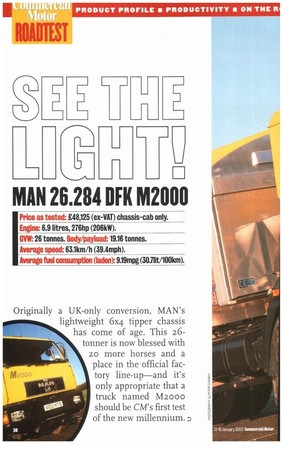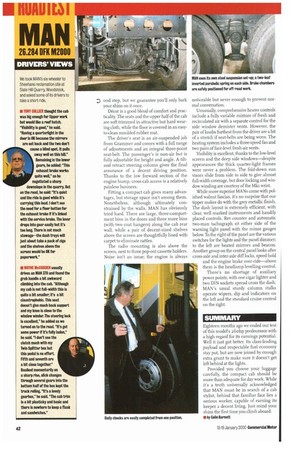MAN 26.284 DFK M2000
Page 40

Page 42

Page 43

Page 44

If you've noticed an error in this article please click here to report it so we can fix it.
IPrice as tested: £48,125 (ex-VAT) chassis-cab only. Engine: 6.9 litres, 276hp (206kW). GAY: 26 tonnes. Body/payload: 19.16 tonnes. Average speed: 631km/h (39.4mph). Average fuel consumption (laden): 919mpg (30.71it/100km).
Originally a UK-only conversion, MAN's lightweight 6x4 tipper chassis has come of age. This 26
tonner is now blessed with 20 more horses and a place in the official factory line-up—and it's only appropriate that a truck named M2000 should be CM's first test of the new millennium. -_-, t's riot often in this Euro-world, where driving on the left is sometimes seen as deviant behaviour, that a product is designed especially for the UK. It's even rarer when our Continental cousins think "that's a good idea—we'll have some of that". But MAN's lightweight 6x4 tipper chassis is just such a beast.
PRODUCT PROFILE
Launched at TipCon '97 as a converted 17-tonner with a Hendrickson rear bogie and a nominal 260hp engine, the 26.264 was originally created to fill a UK-specific niche, but it has earned a place in MAN's pan-European portfolio.
And not only as a tipper—on our recent visit to Bavaria to try out MAN's range of Euro-3 engines, the 6)(4 26-tonner appeared with a general-distribution dropside-and-tilt body.
The 26.284 tested this week is an official factory-built model and its 6.9-litre engine has gained some extra output. Power is up from 257 to 276hp and torque from r,000 to LrooNm. The torque plateau now starts 2oorpm lower, at 1,2oorpm; it still extends to 1,7oorpm.
Hendrickson's rubber suspended rear bogie fitted to the original has been ditched in favour of an in-house steel setup, using a twoleaf inverted parabolic spring on each side attached to the same MAN single-reduction axles as before. Location is by a pair of diff-topmounted A-frames.
The steel front end with its MAN dropped axle is unchanged, as is the front disc/rear drum braking system.
Major chassis options include an extra 2.5m of wheelbase, anti-lock brakes and a drawbar package.
The direct-top Eaton gearbox has eight normal speeds and a crawler; it drives through a 4.11:1 final-drive ratio to give a theoretical top speed of 72mph (an optional 462:1 ratio gives a theoretical 64mph).
The major change to the Steyr-sourced cab is in its name: the L-type has become the Urban cab, with the option of the Urban sleeper which is presumably the opposite to an urban warrior! Combining the small cab, which is more suitably proportioned for a 7.5tonner, with the seriously chunky looking running gear results in an almost toy-like appearance. No-nonsense steel bumper notwithstanding, the MAN presents a rather benign road presence overall.
PRODUCTIVITY
The tipper sector is notoriously sensitive to payload, and in the payload stakes the MAN 26.284 is still king. Despite the extra few kilos added by the change from rubber to steel suspension, it still manages a body/payload allowance of 19 tonnes, even on steel wheels. As tested, on Speedline alloys with a Charlton Tiplite Groundhog body, Meiller/Harsh front
end lifting gear and Dawbam Evertaut Rollover system, it leaves the yard ready to carry a whisker over 17 tonnes.
Making full use of that payload will need some conscientious loading, however, if axle overloads are to be avoided, The 19-tonne plating of the z1-tonne-design rear bogie leaves just 500kg of spare capacity to play with. Our trip over the scales with an evenly distributed load saw the rear bogie spot on with all the margin on the front end.
The overall fuel economy of 9,19mpg is down on the previous 260hp version (consumption was not helped by the lower density of the current ULS diesel fuel) but it's still more than respectable, beaten in our comparison tables only by the Hino with its 4ohp power advantage.
Journey times, of great importance to tipper operators if it means squeezing an extra load into the day, haven't suffered. The MAN's overall 63. ikm/h still gives it the edge on the rest of the group.
And not much of the driver's time will be spent carrying out daily checks. Coolant and engine oil levels are checked from the nearside rear corner of the cab, while the screen wash lives in a transparent container behind the driver's step. Stolen fuel and batteries shouldn't eat into your operating costs, with a locking fuel cap and padlock brackets on the battery box.
Your type of operation will largely dictate the choice of three or four axles, but how do other factors affect the bottom line? Compared with MAN's own 32.364 8x4 tested recently (CM 16-22 December 1999), the six-wheeler's only dear disadvantage is the loss of around four tonnes of payload with a similar body design. In the credit column is the £13,000 saving on list price; a £2,060 reduction in VED; nearly an extra mile per gallon in fuel—and, of course, one less pair of tyres and brakes to wear out. Both come with MAN's "Triple A" package, which gives two years' full repair and maintenance.
ON THE ROAD
The MAN may be down on power compared with the 3oohp-plus opposition, but you really wouldn't know it from the driver's seat. On motorways and A-roads alike it takes a significant hill to cause resort to the gear lever, and when this 6x4 does encounter a challenge it revels in it, romping up Edge Hill in a superb zmin 15sec. Our usual session at the proving ground revealed an unusual problem: we ran out of test hills. The steepest hill, 1-in-3, was laughed off with the 26,284 left begging for more. Goodness knows who would need the shorter axle ratio.
Those 20 extra horses have knocked nearly six seconds off the o-8okm/h standing start,
halving the powerful Hino's lead and putting the MAN in the same league as the other two contenders in our comparison group. The rolling acceleration figures show a similar improvement. The broad spread of torque means that nine gears are quite sufficient and makes this an easy truck to drive efficiently.
The MAN's steel suspension rides well and made light of the usually challenging section between Brackley and Buckingham, although it was badly caught out by a disgraceful trench across the road out of Banbury which was literally teeth-jarring.
There is very little body roll with progress through roundabouts being limited more by the relatively slow steering; the steering wheel itself is large and old-fashioned. Two downshifts are all that are needed to cope with most islands.
The shift plane of the nine-speed Eaton box is slightly angled back and right; if you attempt to move the lever straight backwards it has a tendency to baulk. The "slap across" range-change detents are acceptably driver friendly, but a degree of concentration is still needed to avoid bouncing out. A dashboard warning light confirms that high range is safely engaged.
In these days of proliferating speed cameras the speed-hold device, which works with the cruise control to prevent the truck exceeding the speed selected by the driver, is useful, but we wonder how many tipper drivers will actually use it.
On the road the service brakes performed perfectly adequately at all speeds, but the rear bogie locked up a little early during the test track emergency stop from 64km/h. The MAN still pulled up perfectly straight, but it might be a different story when running unladen on a bend with a wet road surface so maybe the ABS option is worth considering.
As usual, the exhaust brake needed a couple of downshifts to give of its best but eventually made a useful contribution. Our previous criticism of the exhaust brake button's position well behind the driver's left foot remains valid, but on the latest models MAN has alleviated the problem by altering the way it works. The button no longer needs to be held down continuously—one touch leaves it on until it is released by pressing it again or by applying the footbrake.
CAB COMFORT Access into the Urban cab is not particularly easy as the doors don't open the full 90° and the door bin gets in the way of the fuller frame favoured by tippermen (and CM testers). The lower step is set back slightly behind the sec
ond step, but we guarantee you'll only bark your shins on it once.
Decor is a good blend of comfort and practicality. The seats and the upper half of the cab are soft trimmed in attractive but hard wearing cloth, while the floor is covered in an easyto-clean moulded rubber mat.
The driver's seat is an air-suspended job from Grammer and comes with a full range of adjustments and an integral three-point seat-belt. The passenger's is non-air but is fully adjustable for height and angle. A tiltand retract steering column gives the final assurance of a decent driving position. Thanks to the low forward section of the engine hump, cross-cab access is a relatively painless business, Fitting a compact cab gives many advantages, but storage space isn't among them. Nonetheless, although ultimately constrained by the walls, MAN has obviously tried hard. There are large, three-compartment bins in the doors and three more bins (with two coat hangers) along the cab rear wall, while a pair of decent-sized shelves above the screen are thoughtfully lined with carpet to eliminate rattles.
The radio mounting is also above the screen, next to three pop-out cassette holders. Noise isn't an issue: the engine is always noticeable but never enough to prevent normal conversation.
Unusually, comprehensive heater controls include a fully variable mixture of fresh and recirculated air with a separate control for the side window demister vents. However, the pair of knobs furthest from the driver are a bit of a stretch if seat-belts are being worn. The heating system includes a three-speed fan and two pairs of face-level fresh-air vents.
Visibility is excellent, thanks to the low-level screen and the deep side windows—despite appearances the thick quarter-light frames were never a problem. The fold-down sun visors slide from side to side to give almost ftdl-width coverage, but door locking and window winding are courtesy of the Mki wrist.
While more superior MANs come with polished walnut fascias, it's no surprise that our tipper makes do with the grey metallic finish, The dash layout is extremely efficient, with clear, well marked instruments and handily placed controls. Rev counter and automatic two-man tachograph sit either side of the warning light panel with the minor gauges below. To the right of the panel are the various switches for the lights and the panel dimmer; to the left are heated mirrors and beacon. Another group on the central panel looks after cross-axle and inter-axle diff locks, speed hold and the engine brake over-ride—above them is the headlamp levelling control.
There's no shortage of auxiliary power points, with one cigar lighter and two DIN sockets spread cross the dash. MAN's usual sturdy column stalks operate wipers, dip and indicators on the left and the standard cruise control on the right.
SUMMARY
Eighteen months ago we ended our test of this model's 26ohp predecessor with a high regard for its earnings potential. Well it just got better. Its class-leading payload and respectable fuel economy stay put, but are now joined by enough extra grunt to make sure it doesn't get left behind at the lights.
Provided you choose your luggage carefully, the compact cab should be more than adequate for day work. While it's a truth universally acknowledged that MAN must be in search of a cab stylist, behind that familiar face lies a serious worker, capable of earning its keeper a decent living. Just mind your shins the first time you climb aboard.
• by Colin Barnett




















































































































